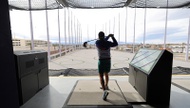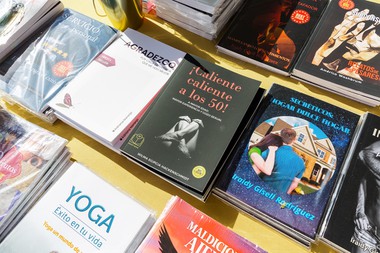There are dozens of coffee-table photo books on Las Vegas currently in print. I’m going to go out on a limb and say that if you live in this Valley—here in the midst of all this brilliantly lit, eminently photo-worthy licentiousness and prolificacy—you only need one of them: Fred Sigman’s recently-published Motel Vegas (Smallworks Press, $30).
Sigman began documenting the 1950s-vintage motels of Fremont Street, Boulder Highway and North Las Vegas in the mid-1990s, using a conspicuously bulky large format view camera that produced 4-by-5-inch Fujichrome tranparancies. (If you feel self-conscious about whipping out your iPhone in a sketchy neighborhood, imagine how Sigman felt trucking around with a big, obvious camera in pre-revitalization Downtown.) The resulting images are nostalgic, but also bracingly current; many of these decaying properties are still standing and only slightly more timeworn. (And the Neon Museum, bless it, has preserved the signs of the ones that didn’t make it.)
In anticipation of a May 25 book release event at the Nevada State Museum, Sigman spoke to the Weekly about the motivation behind this longtime passion project.
What convinced you that Vegas’ motels needed to be documented? I was approached by Ivan Karp, of OK Harris Works of Art in New York City. Ivan used to come to Las Vegas to gamble, rather frequently. … [We] hung out a couple nights, and then he and I just strolled down Fremont Street one evening, when Fremont Street was a little bit rougher than it is now. He looked at the motel signs, and he said, “These signs are going to be destroyed.” [People know Ivan] mostly because he was Andy Warhol’s dealer for many years, but he was also an active architectural preservationist in New York City. ... He said, “There’s nothing we could do to stop their demolition,” but, “I would like them at least photographically archived.”
Some of them still stand. What happens to Vegas if we lose those motels? Let me work out the answer to that. I went to high school here. I went to Bishop Gorman, and during those days I started photographing down in the Las Vegas Wash, back in the ’70s when it was 5,000 acres of cattail swamp. Now, it’s a f*cking county park with picnic tables, interpretive signage, a visitor center and all that stuff. … Everything that was wild about that place is gone.
From a personal point of view, what we’ve lost here is that the community no longer can experience a wild state, no matter how man-made it could have been. With that thought in mind, I look at the kind of experiences these motels can offer us: that’s what we lose, we lose the experience of these motels. And that’s sometimes a scary damn experience, I’ll tell you. I wasn’t trying to romanticize or anesthetize these things; these places were as run down then, as some of them are now. The only way I could fully understand the property was to spend a night in it.
For a lot of people, what is eventually lost is not just a sign, because you know, you put them in the Neon Museum, so the sign is saved. And that’s great. I mean, I love art museums like the next person. But I’ve been through them all, seen all the dusty old brown paintings in Europe—and while I love to see them in those museums, what’s gone is the kind of experience people would have engaging those works of art in castles, private homes, or wherever. It’s the essential experience that these motels can provide.
Speaking of interesting experiences, are there any photos in this book you feel lucky to have taken? Page 55, the Clark Inn Motel. The building, the motel and stuff was long gone, but the sign stood there for a few years after the demolition. I didn’t include a lot of people in my photographs. I kind of sometimes wish I had, but I probably would not have made them a part of this series; I would consider them in a different context. If you go through the book, there’s probably four, maybe five pictures in the book that actually have people in them. This photo is the one that’s the most obvious: [A] prostitute who was across the street started calling out to me. With the view camera, I kind of stand out.
She ended up coming over across the street, protesting how she did not want me to photograph her: “I don’t want you taking my picture.” Then, she looked at my camera, and she didn’t know what kind of camera that was, and she asked, “Are you making movies?” It was on a tripod and all that, so before I could answer, “No,” she said, “OK, turn that thing on, and get the film rolling,” and then she just walked right in front of the camera like you see. It was absolutely perfect.
While the [Clark Inn] sign isn’t my favorite sign, it’s one of my favorite photographs, because while just about every picture I took in here there was some human interaction that I was engaging with someone out of frame. Maybe it was the motel manager, or one of the guests, or drug dealers. View cameras, with a big black thing you put over your head to look on the frame, tend to attract attention.
Fred Sigman: Motel Vegas May 25, 2 p.m, free with Springs Preserve admission. Nevada State Museum, 702-486-5205.








